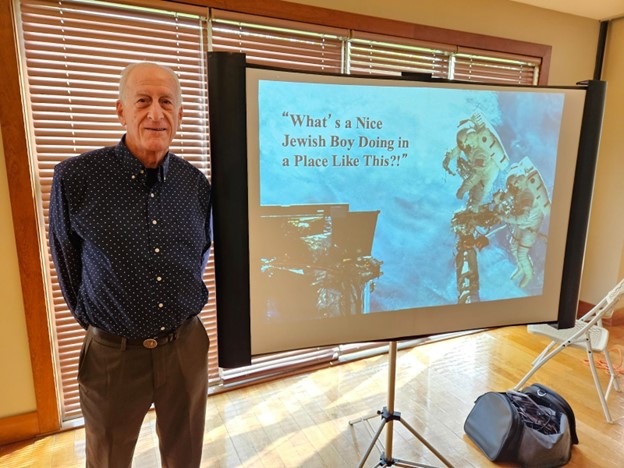What mother doesn’t want her child to grow up to be an astronaut? We learned this on Sunday May 12 (Mother’s Day) at Congregation Beth Elohim when Astronaut Dr. Jeffrey Hoffman presented his documentary Space Torah to an audience of about 50 congregants and community members.
Dr. Hoffman has spoken about his career to many audiences, including Jewish audiences. But it wasn’t until 2016 that a local movie producer suggested he make his story into a short movie. Several years later, the Space Torah documentary has been hitting the local film festivals.
The film focuses on Dr. Hoffman’s path to becoming an astronaut, and how he carried his Judaism into space. Like many people, Dr. Hoffman changed his career and chased his passion. Growing up in New York, he gazed at the stars and read books about astronomy. Thanking one of his teachers, he brought one of those books into space.
How did that happen? He didn’t expect to become an astronaut, but after settling into an academic career in astrophysics at the Massachusetts Institute of Technology, he learned about an opportunity to join NASA. NASA was opening its astronaut program to scientists and engineers, not just to military test pilots. Dr. Hoffman had “the right stuff” and was selected among thousands of applicants. Starting in the 1980s, he logged over one thousand hours over five space shuttle flights, including four spacewalks, and is a member of the Astronaut Hall of Fame.
He described one spacewalk fixing the Hubble telescope as especially noteworthy. He trained for over a year, partly underwater to mimic zero gravity conditions to install and replace the optics of the telescope using a bulky space suit. Repairing a telescope that looks at the origins of the universe was an important and meaningful mitzvah for Dr. Hoffman. There is a tradition in modern Judaism called Tikkun Olam, or “repairing the world”.Fixing the Hubble telescope optics, which allowed scientists to make discoveries about the earth’s place in our universe, was an act of Tikkun Olam.
The central focus of the film describes the process for bringing a Torah (sometimes called the Hebrew Bible) into space. Stationed in Houston, Dr. Hoffman worked closely with the rabbi of his congregation. Preparing the Torah was not a simple task. Because of space limitations, he brought a smaller torah and was able to unscroll one page and read from it in space with a “yad”, a ritual pointer that is used to touch the Torah scroll. In space, looking at the Earth, he said a blessing and read from Genesis – “Beresheet”, “In the beginning, God created the earth…” Upon return, the page was reattached to the rest of the scrolls and has since been used in many bar and bat mitzvahs in the congregation. Dr. Hoffman is especially grateful to his Rabbi and his congregation for allowing future generations to connect to this profound journey.
After the presentation of the film, Dr. Hoffman took several questions from the audience.
Was he a Star Wars or Star Trek fan? He didn’t seem to take the bait, but he is a champion of space exploration. He marvels at the science and engineering of the James Webb telescope and the efforts of private companies, like SpaceX and Blue Origin planning trips to Mars.
In addition to bringing a Torah into space, he also brought a mezuzah, a small ritual container that Jews traditionally nail to doors of their dwellings, and which contains a small scroll of parchment with a Hebrew prayer. The mezuzah is designed to be portable and is traditionally believed to provide special “protection” to the occupant. It is not surprising, then, that he would also carry a mezuzah into space. Instead of nailing it to the insides of the shuttle, however, he used Velcro.
We were treated to a breakfast of bagels, lox, and whitefish salad, and in a nod to the astronaut theme, Tang. We later learned that Dr. Hoffman did not drink Tang, as it was too sweet. He also asked the NASA technicians to replace a vile salty electrolyte solution used to recover from zero gravity conditions, which affects blood circulation. Dr. Hoffman was not a fan of this solution’s taste, so NASA eventually found one that worked for him: chicken soup.
This talk was the last talk in a series of four this (Jewish) year at Congregation Beth Elohim sponsored by the Scientists and Synagogues Initiative.
Matt Liebman is the Acton Exchange correspondent from Congregation Beth Elohim.

